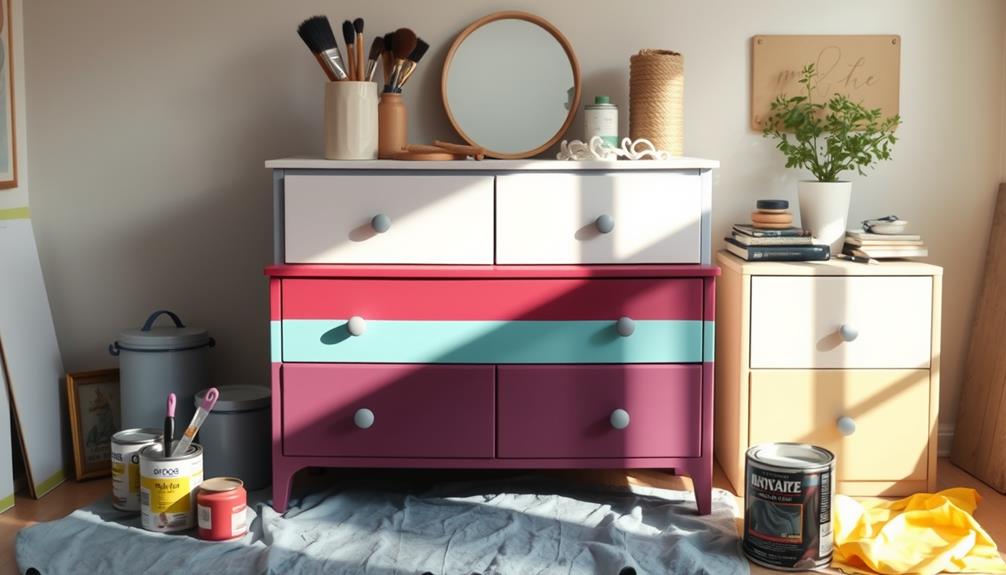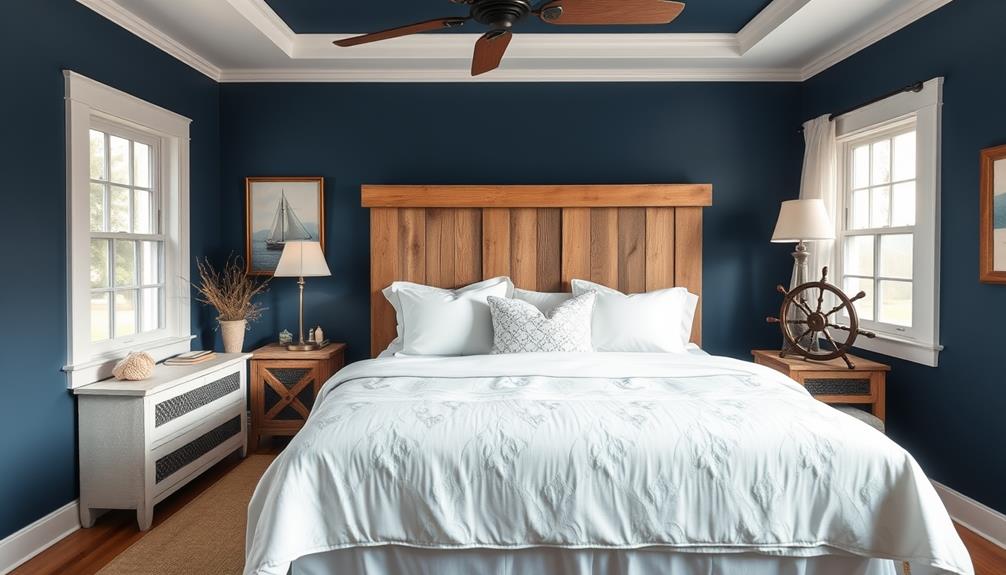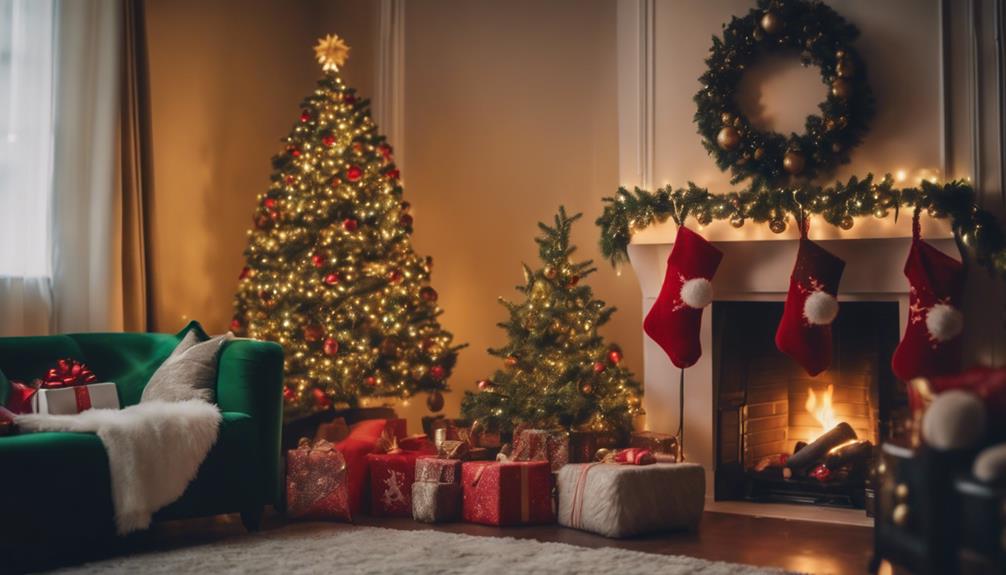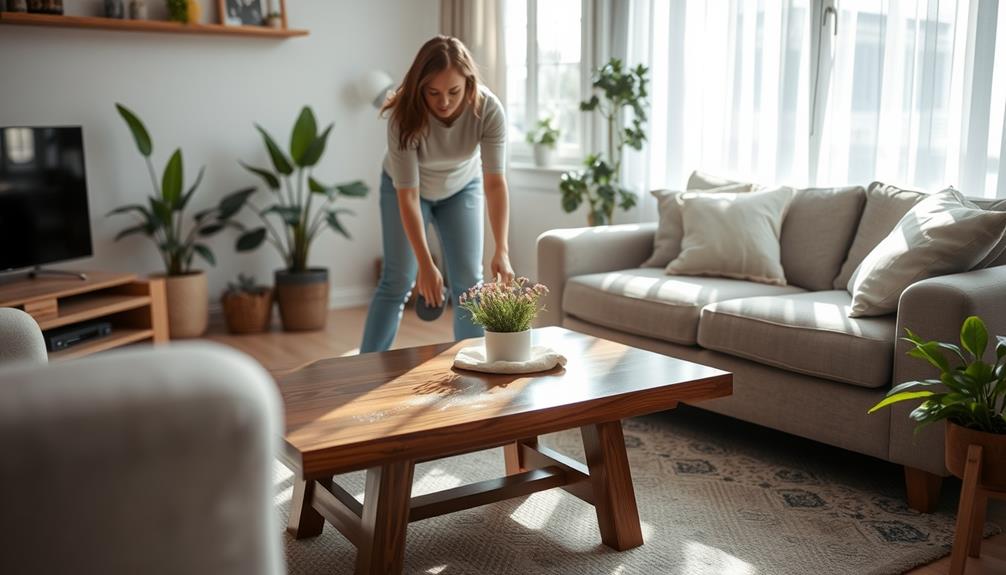To paint laminate furniture, you should first clean the surface thoroughly to remove any dirt and grease. Then, lightly sand it with 220-grit sandpaper to help the paint adhere better. Next, apply a primer that is shellac-based in thin layers, making sure to let it dry and sanding in between coats. Once the primer is applied, use acrylic-based paint and apply multiple thin coats for a smooth finish. Allow each coat to fully dry before adding the next one. After painting, wait 72 hours before using the furniture to ensure it is durable. By following these steps, you will be well-prepared to transform your laminate furniture pieces, and there are other techniques you can explore to perfect your skills.
Key Takeaways
- Thoroughly clean the laminate surface to remove dirt and grease before painting for better primer adhesion.
- Lightly sand the surface with 220-grit sandpaper to enhance paint adhesion and ensure a smooth finish.
- Use a high-quality bonding primer, applying at least two thin coats and sanding between coats for optimal results.
- Apply multiple thin coats of acrylic-based paint, allowing adequate drying time between each coat to avoid drips.
- Maintain the painted surface by cleaning with mild soap and water, avoiding abrasive cleaners to preserve the finish.
Overview of Laminate Furniture Painting
When it comes to revitalizing your laminate furniture, painting can be a game-changer. It's a fantastic way to breathe new life into pieces that might seem outdated or worn.
However, to successfully paint laminate furniture, you need to focus on proper surface preparation. Start by thoroughly cleaning the surface to remove any dirt or grease, similar to how professional cleaning services prepare surfaces for ideal results. Then, lightly sand the laminate to create a rough texture, which helps the paint stick better.
Using a suitable primer for laminate is essential; a shellac-based primer like Kilz Original or INSL-X STIX is highly recommended. This step guarantees that your paint adheres properly and prevents peeling down the line.
Once your primer dries, you can begin applying your first coat of paint. Opt for acrylic-based or waterborne alkyd paints, as they adhere well and provide a durable finish.
Remember to apply multiple thin coats of paint, allowing adequate drying time between each coat to achieve a smooth, professional-looking finish.
You can also get creative by incorporating decorative elements, like faux cane webbing, to enhance the final look of your furniture.
Required Supplies and Preparation
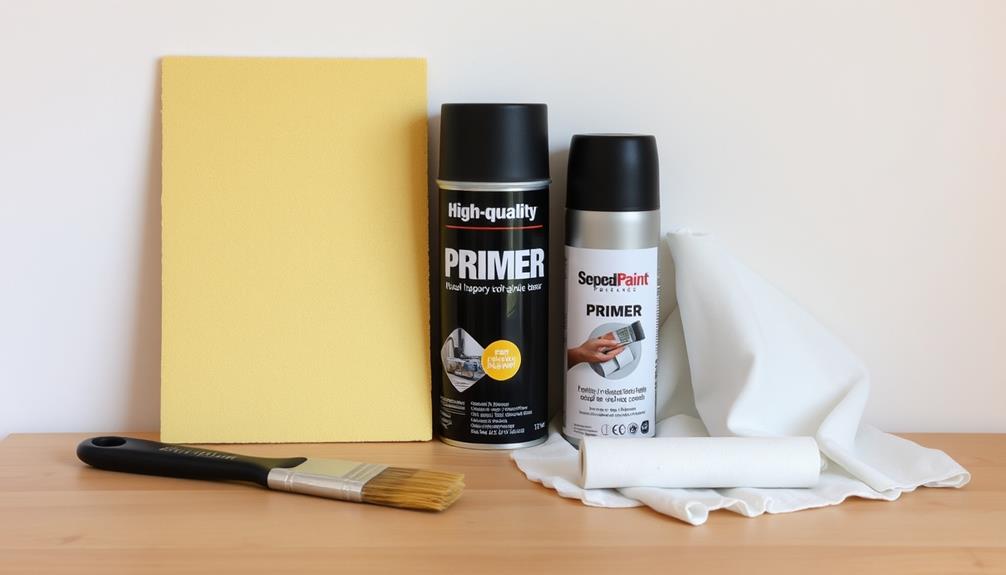
To successfully tackle painting laminate furniture, you'll need to gather a few essential supplies and prepare your workspace effectively. Start with a high-quality primer, such as Kilz Original Primer or INSL-X STIX Primer, which helps the paint to stick to the laminate surface.
For the finish, opt for acrylic-based or waterborne alkyd paint that provides a durable and attractive look. Additionally, consider using essential oils like lavender oil to create a calming atmosphere while you work, making the painting process more enjoyable.
Before you start painting, it's vital to prepare the laminate surface properly. Clean it thoroughly to remove any dirt and grease, then lightly sand it with 220-grit sandpaper. This step enhances adhesion, ensuring the paint sticks well to the surface.
Don't forget your safety gear! A respirator mask is important to protect you from fumes during the process.
For application, use a 1.5-inch angled brush for those detailed areas and a foam roller for smooth coverage on flat surfaces.
Key Painting Tips and Techniques
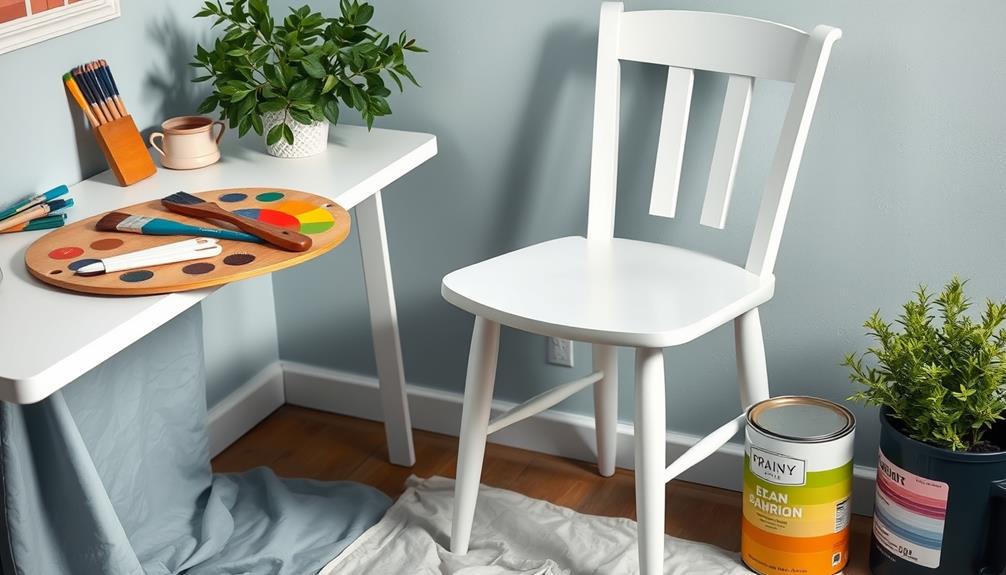
When painting laminate furniture, proper priming is vital for adhesion, so always start with a shellac-based primer.
To achieve the best results, consider selecting high-quality tools, as using the right application methods, like foam rollers for flat areas and angled brushes for corners, can greatly contribute to a smooth finish.
For homes with allergies, ensuring a dust-free environment can also improve the final outcome, making it essential to check out the best vacuums for dust removal in 2024.
Don't forget to allow enough drying time between coats to avoid any bubbling or peeling later on.
Priming for Adhesion
Properly priming laminate furniture is essential for achieving a durable and long-lasting finish. To guarantee your paint adheres well, you need to use a bonding primer that's specifically designed for laminate surfaces. Products like Zinsser B-I-N or INSL-X STIX work wonders for this purpose.
Here's a quick rundown of the priming process:
| Step | Action |
|---|---|
| 1. Choose Primer | Select a high-quality bonding primer. |
| 2. Apply Coats | Apply at least two thin coats. |
| 3. Sand | Sand laminate furniture lightly between coats. |
| 4. Ventilation | Make certain your workspace is well-ventilated. |
Each coat should dry completely before you sand lightly. This step creates a textured surface that improves paint grip, guaranteeing better adhesion. Remember, during the priming process, strong odors may arise from shellac-based primers, so proper ventilation is key. By following these techniques for priming for adhesion, you'll set the stage for a successful paint application, leading to a beautiful and resilient finish on your laminate furniture.
Paint Application Methods
Achieving a professional-looking finish on laminate furniture hinges on mastering effective paint application methods. To start, apply multiple thin coats of paint instead of one thick coat. This helps you avoid drips and guarantees an even coat across the surface. Always allow adequate drying time between each coat, as stated in the manufacturer's instructions. Additionally, it’s crucial to lightly sand between coats to create a smooth surface and promote better adhesion. For those wondering *how to spray paint furniture*, be sure to maintain a consistent distance to avoid overspray and achieve a flawless finish. Lastly, protect your work with a clear sealer to enhance durability and prolong the life of your newly painted furniture piece. Another key tip when learning *how to spray paint furniture* is ensuring proper ventilation in your workspace to minimize fumes and achieve optimal results. It’s also beneficial to use a primer specifically formulated for laminate surfaces, as this will help the paint adhere better and prevent chipping over time. With careful preparation and attention to detail, your refurbished laminate furniture will have a stunning, professional appearance.
For the best results, use a foam roller on flat surfaces to create a smooth finish. For detailed areas and corners, a 1.5-inch angled brush works wonders. Sand lightly between coats with fine grit sandpaper (220-grit or finer) to enhance smoothness and adhesion without damaging the laminate surface.
While painting, confirm your workspace is well-ventilated and wear a respirator mask to protect yourself from fumes. When applying your coat of primer and paint, maintain a consistent distance of 6-12 inches from the surface. This distance guarantees maximum coverage and minimizes overspray, giving your laminate furniture a polished look.
Drying and Curing Time
To guarantee your painted laminate furniture looks great and lasts, understanding drying and curing times is vital. Start by allowing your primer to dry completely for 1-2 hours before applying the first coat of paint. This promotes ideal adhesion and prevents lifting. Once you've painted, let the first coat dry to the touch, usually 2-4 hours, before lightly sanding it for a smoother finish. You can then apply the second coat, following the same drying process.
After painting, it's important to let the paint cure for at least 24-48 hours before heavy use. This period allows the paint to harden and develop durability. Keep in mind, drying times can vary based on environmental conditions; painting in low humidity and moderate temperatures can enhance efficiency. For clear topcoats, wait at least 72 hours for curing before placing items on the surface to guarantee protection against scratches.
Here's a quick reference table on drying and curing times:
| Task | Time Required |
|---|---|
| Primer Drying | 1-2 hours |
| First Coat Drying | 2-4 hours |
| Second Coat Curing | 24-48 hours |
| Clear Coat Curing | 72 hours |
Step-by-Step Painting Process

Before you immerse yourself in painting your laminate furniture, it's crucial to prepare the surface properly for the best results.
Start by thoroughly cleaning the laminate to remove any dirt and grease, which guarantees the primer adheres well. Next, lightly sand the surface with fine-grit sandpaper (220-grit or finer) to create texture, then wipe it down to eliminate dust.
Now, it's time to apply a shellac-based primer, like Zinsser B-I-N, in thin, even coats. Allow the primer to dry completely, and lightly sand between coats for a smooth finish.
Once the primer is dry, you can move on to the paint job. Apply 1-2 even coats of acrylic-based or waterborne alkyd paint, making sure to follow the manufacturer's instructions for drying time between coats.
Maintenance and Care
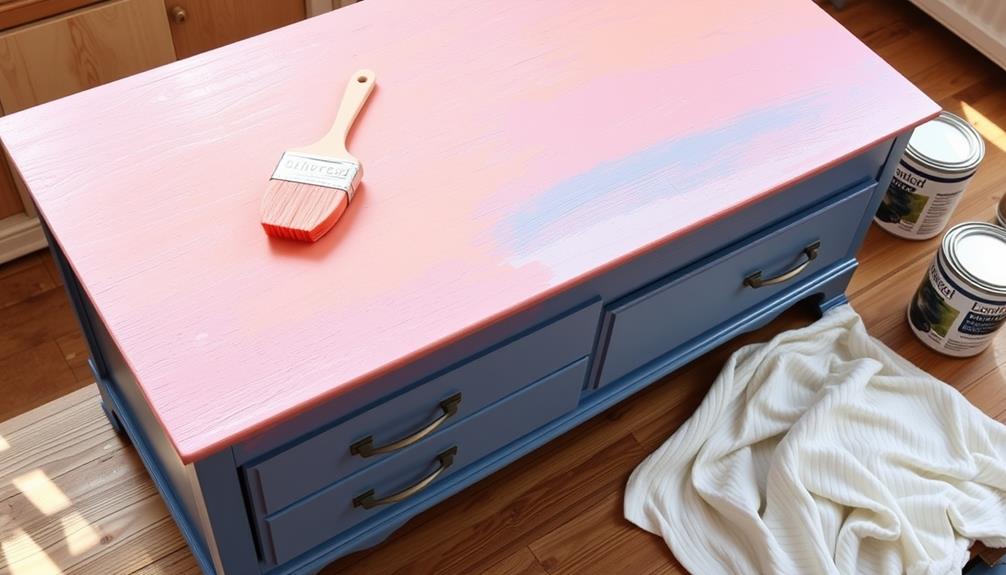
While you've put in the effort to paint your laminate furniture, maintaining that fresh look requires regular care.
Start by cleaning the surfaces regularly with a mild soap and water solution. This simple maintenance step prevents dirt buildup and helps preserve the paint finish.
Be cautious, though; avoid abrasive cleaners or scrubbers, as they can damage the paint and lead to premature wear and chipping.
To protect your painted laminate surfaces, always use coasters and placemats. These small additions can help prevent scratches, stains, and heat damage from everyday use.
Periodically inspect your furniture for any chips or scratches, and perform touch-ups as needed to keep it looking its best.
Understanding Laminate Materials

When you consider furniture options, understanding laminate materials is vital for making an informed choice. Laminate furniture consists of synthetic materials, primarily plastic, which creates a durable exterior that mimics the look of real wood. This design gives you an attractive appearance without the cost of solid wood.
One key aspect to remember is that laminate can't be stained like real wood. Instead, painting is your best option for changing its aesthetic. The laminate surface is constructed by bonding layers of various materials, which include a decorative layer, core layer, and backing layer. This layered approach contributes to its durability and affordability, making laminate a popular choice for budget-conscious shoppers.
Additionally, it's important to distinguish between laminate and wood veneer. Unlike laminate, veneer features a real wood layer that can be sanded and stained, providing more flexibility for aesthetic changes.
Understanding these differences will help you choose the right furniture for your needs and guarantee you select the appropriate paint color for your laminate pieces.
Cleaning Process for Laminate
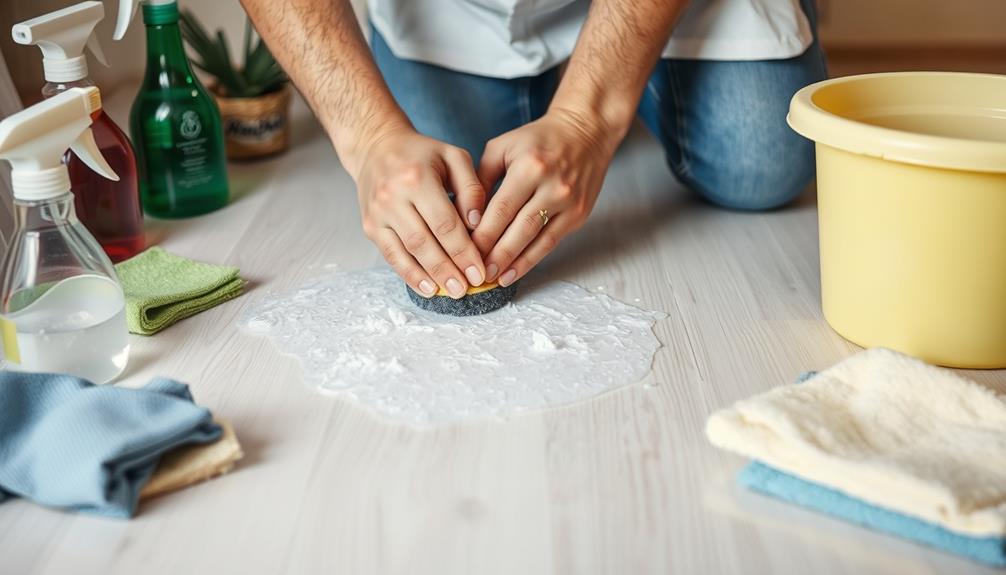
Regularly cleaning your laminate furniture is important for preparing it for painting. Start the cleaning process by using a wet rag to thoroughly wipe down the laminate surface. This step removes any dirt, dust, or grease that could interfere with paint adhesion later on.
It's essential to make certain the surface is completely dry after cleaning, as any residual moisture can affect the application of primer and paint.
For best results, consider using a cleaning product like Gloss Off, which effectively breaks down oils and residues, making the laminate surface ready for painting. Be cautious, though; avoid harsh chemicals or abrasive cleaners, as these can damage the laminate finish and create imperfections that will ruin your final paint job.
Once you've cleaned the surface, take a moment to inspect it for any damage or imperfections. Addressing these issues now will save you headaches later when you move on to sanding and painting.
A clean and well-prepared laminate surface is crucial for achieving a smooth and durable finish, setting the stage for a successful transformation of your furniture.
Priming and Painting Techniques
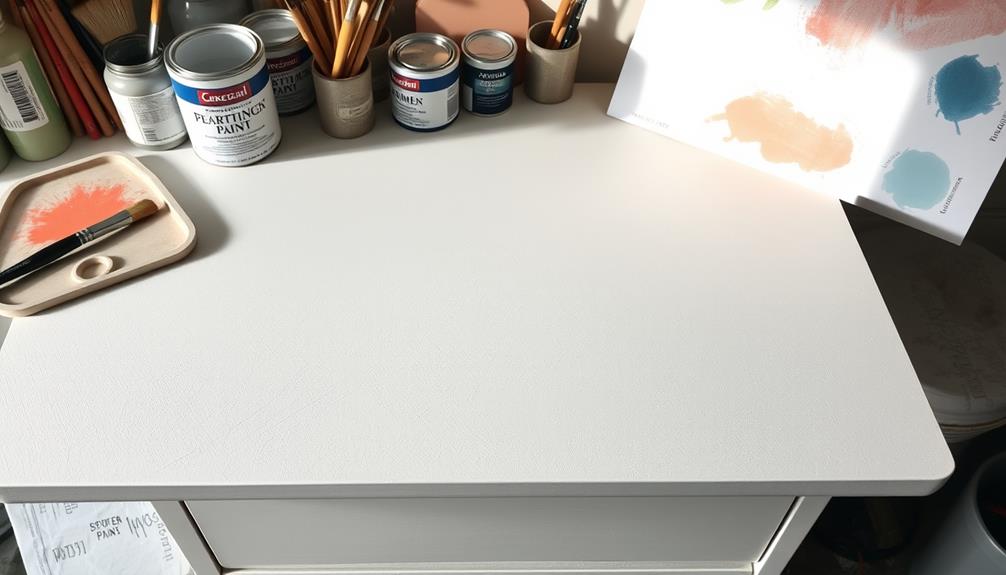
When it comes to painting laminate furniture, proper priming is essential for ensuring that your paint sticks and stays put.
You'll want to use a quality primer designed for laminate surfaces and apply it in thin, even coats.
Once primed, effective painting techniques, like using multiple thin layers of paint and lightly sanding between coats, will help you achieve a smooth and durable finish.
Importance of Proper Priming
Proper priming is an essential step in painting laminate furniture, and skipping it can lead to disappointing results. Priming is vital for achieving proper paint adhesion on laminate surfaces, preventing the paint from beading up and guaranteeing an even finish.
To set the stage for success, choose a high-quality bonding primer, like Zinsser B-I-N, which enhances adhesion without requiring sanding. This makes your painting process smoother and more efficient.
It's recommended to apply at least two coats of primer to effectively cover the surface and block any stains or odors. This creates a solid foundation for the paint.
Between primer coats, lightly sanding the surface can greatly improve paint grip and contribute to a smoother final finish.
Don't rush the process—allow the primer to cure completely before moving on to the paint. This step is essential for durability, helping to prevent peeling or chipping of your topcoat.
Effective Painting Techniques
To achieve a flawless finish on your laminate furniture, start by applying multiple thin coats of paint rather than one thick layer. This method helps to prevent drips and guarantees an even finish.
Follow these effective painting techniques:
- Apply a high-quality bonding primer like Zinsser B-I-N. Use at least two coats and let each coat cure fully.
- Lightly sand the primed surface between coats of paint. This enhances smoothness and helps improve adhesion. Don't forget to clean off any dust with a microfiber cloth afterward.
- Use a foam roller for flat sections to achieve a smooth finish. For corners and detailed areas, grab a small angled brush to avoid any brush strokes in those hard-to-reach spots.
- Ensure proper ventilation during the entire process. Both the primer and paint can emit strong odors, so always wear a respirator mask for your safety.
Common Challenges and Solutions
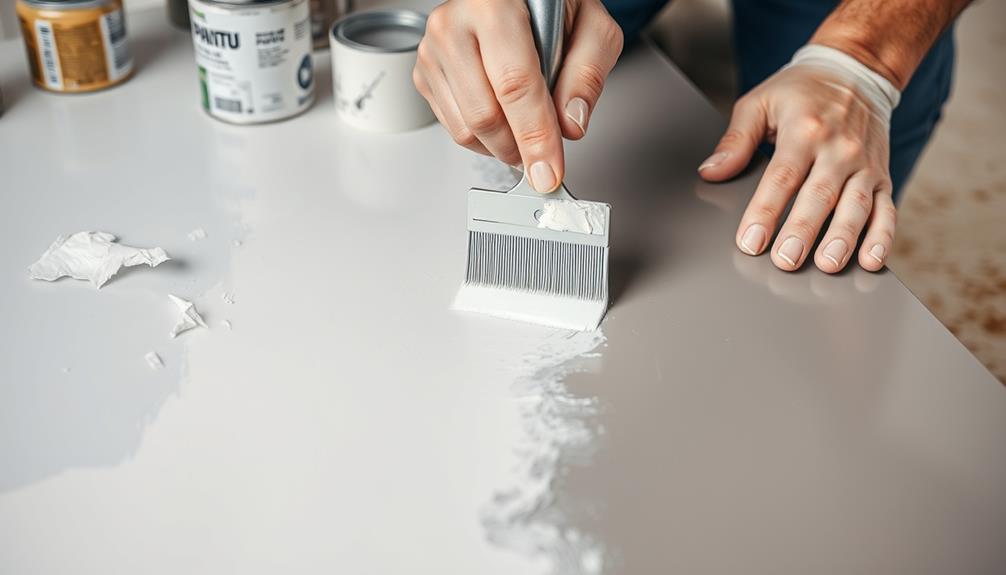
Painting laminate furniture can present several challenges, but with the right approach, you can achieve a beautiful finish. One common issue you might face is bubbling, which often stems from inadequate surface preparation. To avoid this, make sure you thoroughly clean and prime the surface.
If you notice the paint peeling after application, it's a sign you may need a stronger bonding primer, like Zinsser B-I-N, to help with adhesion on laminate surfaces.
Another challenge is achieving a smooth finish. Instead of applying a thick coat, apply multiple thin coats of paint. This method not only reduces the risk of drips but also allows each layer to dry properly, enhancing the overall appearance.
If your furniture has dents or damage, don't skip the filler; it's important to smooth out imperfections before priming and painting.
Lastly, be mindful of strong odors from primers and paints. To reduce discomfort, work in a well-ventilated space or outdoors.
Frequently Asked Questions
What Kind of Paint Do You Use on Laminate Furniture?
When choosing paint for laminate furniture, you should use acrylic-based or waterborne alkyd paints. They adhere well and provide durability. Avoid oil-based paints, as they may lead to peeling and unsatisfactory results.
How Do You Get Paint to Stick to Laminate?
You can't just throw paint on laminate and hope for the best! Clean it thoroughly, sand lightly, use a quality primer, and apply thin coats. Trust me, your paint will stick like magic!
Can You Paint Straight Over Laminate?
You can't just paint straight over laminate. If you skip proper preparation, you'll likely face peeling and chipping. Using a good primer and prepping the surface guarantees better adhesion and a longer-lasting finish.
Can You Paint Laminate Furniture Without Sanding It?
Imagine a canvas waiting for your brush. Yes, you can transform laminate furniture without sanding! Just choose the right chalk paint or bonding primer, clean the surface, and watch your vision come to life effortlessly.
Conclusion
In summary, transforming your laminate furniture into a stunning masterpiece is not just a project; it's a grand odyssey of creativity! With the right supplies and a sprinkle of patience, you'll elevate your space to a domain of elegance previously thought impossible. Remember, every brushstroke is a declaration of your artistic prowess, turning the mundane into the extraordinary. So, grab your paint and let your imagination soar—your furniture is just waiting for its dazzling makeover!
